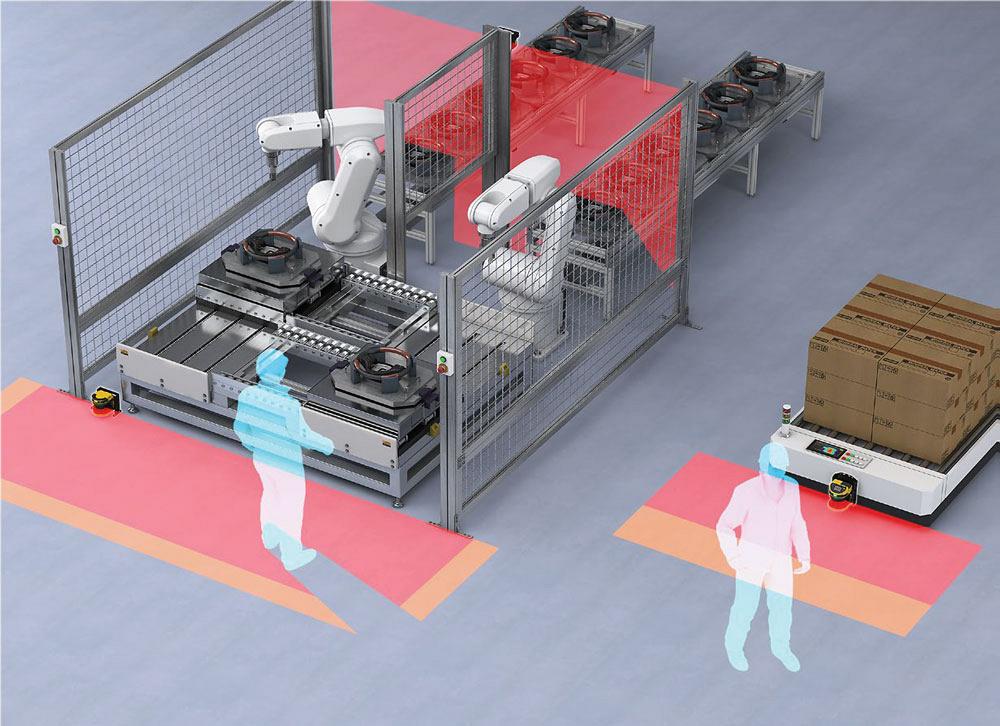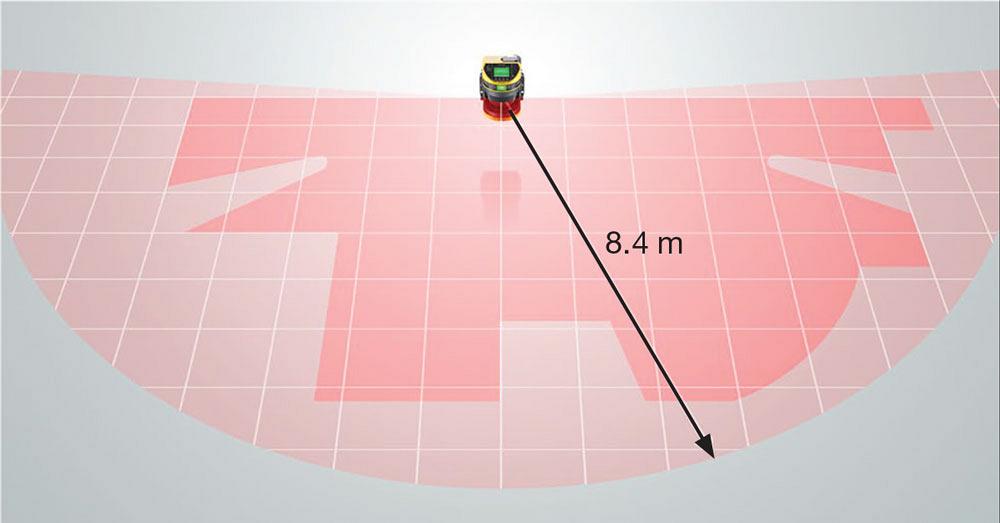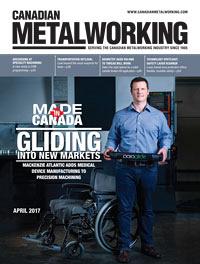Editor
- FMA
- The Fabricator
- FABTECH
- Canadian Metalworking
Technology Spotlight: Safety Laser Scanner
Laser-based area protection offers flexible, scalable safety
- By Joe Thompson
- Updated February 13, 2023
- April 27, 2017
- Article
- Management

The SZ-V laser scanning unit can be mounted horizontally, vertically, and even attached to automated guided vehicles. Image courtesy of Keyence.
Protecting workers is paramount in any shop. And, the types of safety systems available on the market today are as numerous as the parts these shops create.
At the lowest end of the safety scale are simple lines painted on the floor and fencing that literally keeps workers separated from equipment. Even as shops move toward a more lights-out operating philosophy, machinists, operators, programmers, and service technicians still need access to different areas of a machine tool or cell.
Also, as automation becomes the norm, even on stand-alone machines, shop employees are working in close proximity to moving doors, panels, and robots.
New, laser-based area scanning systems are now becoming commonplace and are typically used in two types of situations.
1. Area protection.
Safety scanners protect an area of floor space to keep people and shop vehicles away from dangerous or sensitive areas. Unlike safety mats, these scanners are mounted but still protect complex shaped areas.
2. Denying access.
Scanners can also be mounted vertically to detect entry into hazardous areas. Mounting the scanners in this type of configuration is a good option when it is too difficult to use light curtains.
A new technology released in mid-2016 by Keyence, Mississauga, Ont., is the SZ-V series of safety laser scanners.
“These scanners are a great replacement for safety mats because they are unobtrusive but can still protect a large area,” explained Neil Puri, national sales manager – automation group. “Typically the scanners are installed during a new build or installation, but they can be retrofitted into existing setups.”

The SZ-V has a scanning reach of 8.4 metres and can differentiate between dust, mist, and solid objects. Image courtesy of Keyence.
Puri also explained that these devices can be used in conjunction with other technology, such as light curtains, to create safety zones in multiple locations around equipment.
These particular laser scanners have a 190-degree field of view and can reach lengths of 8.4 metres for the protection zone and 26 m for the warning zone. The 8.4-m reach is the longest of any in the industry, according to Puri.
The laser scanner has a detachable display that provides feedback, zone information, and recorded historical data, all of which can be accessed without interrupting operation.
Up to three units can be connected together to expand the coverage area. The scanners in this type of situation can be up to 20 m apart and use multiple scanning heads connected to a single display unit. This enables shops to monitor multiple sections of a machine without needing wiring.
The scanners connect to a computer via USB or Ethernet to modify programming, monitor the status of the scanner, and, most importantly, check for recent interruptions. The Ethernet connection also allows for several different networking options including TCP/IP, UDP, and EtherNet/IP™.
Defining the Protected Area
Software is included with the scanner to enable users to generate the safety zones in three ways.
“The first way to define an area with the software is really as simple as point and click,” said Puri. “You can draw around obstacles to create even the most complex shapes.”
This drawing method even automatically locates physical objects in the shop, such as walls and pillars to ensure proper zone creation.
The second zone-creation tool is the system’s automatic drawing function. The software automatically draws around obstacles.
The third method uses specialty reflectors to create custom zones by marking the corners of the desired zone. This function can be used to generate simple square zones, as well as complex polygonal areas.

Laser-based area scanning systems like the SZ-V from Keyence are now becoming commonplace and are typically used in two types of situations: area protection and denial of access. Photo courtesy of Keyence.
How It Works
“The laser technology really is the heart of the system,” said Puri. “It’s what sets this system apart from other laser scanners. For example, we think that because of this technology we can detect more events, but also more non-events. This helps keep people safe but also reduces downtime caused by unnecessary machine stoppages.”
This version of the laser scanner has a laser spot diameter that is two-thirds the size of conventional laser scanning devices. And the company increased the number beam axes. This combination, along with a 0.1-degree beam pitch, allows the system to detect targets while at the same time decreasing the number of unnecessary stoppages caused by environmental factors like dust or mist.
It is the system’s Intensity Comparison Algorithm that allows the scanner to analyze the amount of light returned to differentiate between people/objects and dust/mist.
The system also uses multiple axes of laser light in its detection. In a laser scanner using conventional detection, the scanner calls for a stoppage when it detects a target reflecting back a single light axis. Multiaxis detection in this unit only detects a target when several consecutive axes are reflected back.
“Having multiple lasers instead of just one keeps the system from tripping unnecessarily,” said Puri. “It brings more reliability to the setup. Safety systems are a necessary part of every shop, but if they are unreliable or in the way, they won’t be used to their fullest potential.”
Part of that full potential is using all of the functions available. Some models of the scanner are available with built-in cameras. The unit takes pictures or movies before and after the event (Output Signal Switching Device turn off) so users can visually see the cause of trip and react accordingly.
Because these scanners now have an extended range, fewer units need used to protect an area. In the past scanners would be needed at the four corners surrounding a machine, but today only two can handle the same area.
Scanning an area to help keep workers safe is an important task. But it’s also important to track, trace, and understand what is causing shutdowns. This laser scanner has a Detection History feature that allows users to see when, where, and how long detections are occurring. With up to 500 events that can be saved, this feature provides crucial details to better understand machine shutdowns.
It’s not just stationary equipment that can make use of these scanners, either. They can be mounted on the front of an automated guide vehicle to help reduce collisions with objects or people.
The units are compliant with Type 3, SIL 2, Category 3, and PLd safety standards requirements.
Keyence Canada, 888-539-3623, www.keyence.ca
Editor Joe Thompson can be reached at jthompson@canadianmetalworking.com.
About the Author

Joe Thompson
416-1154 Warden Avenue
Toronto, M1R 0A1 Canada
905-315-8226
Joe Thompson has been covering the Canadian manufacturing sector for more than two decades. He is responsible for the day-to-day editorial direction of the magazine, providing a uniquely Canadian look at the world of metal manufacturing.
An award-winning writer and graduate of the Sheridan College journalism program, he has published articles worldwide in a variety of industries, including manufacturing, pharmaceutical, medical, infrastructure, and entertainment.
subscribe now


Keep up to date with the latest news, events, and technology for all things metal from our pair of monthly magazines written specifically for Canadian manufacturers!
Start Your Free Subscription- Trending Articles
Automating additive manufacturing

Sustainability Analyzer Tool helps users measure and reduce carbon footprint

CTMA launches another round of Career-Ready program

Sandvik Coromant hosts workforce development event empowering young women in manufacturing

GF Machining Solutions names managing director and head of market region North and Central Americas

- Industry Events
MME Winnipeg
- April 30, 2024
- Winnipeg, ON Canada
CTMA Economic Uncertainty: Helping You Navigate Windsor Seminar
- April 30, 2024
- Windsor, ON Canada
CTMA Economic Uncertainty: Helping You Navigate Kitchener Seminar
- May 2, 2024
- Kitchener, ON Canada
Automate 2024
- May 6 - 9, 2024
- Chicago, IL
ANCA Open House
- May 7 - 8, 2024
- Wixom, MI















